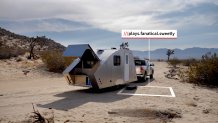Three seemingly nonsensical words can help family members meet at a new trailhead, a nervous person find the right park bench for a first date or a rescue team save a hiker who made a wrong turn.
At the end of June, California State Parks announced its partnership with what3words, a system that helps people communicate locations more accurately by translating GPS coordinates into unique three-word combinations.
For example, “battering.plump.processor” corresponds to a spot along the Cholla Cactus Garden Trail in Joshua Tree, “doodles.blitz.explode” leads to a white picnic table at Wildrose Campground in Death Valley and “bats.enthusiast.season” sits at the edge of Tenaya Lake in Yosemite.
California State Parks plans to use what3words to find people during emergencies and to make visits to parks more convenient, Adrien Contreras, assistant deputy director of park operations, said, adding that hikers get lost “surprisingly frequently.”

What is what3words and how does it work?
What3words has divided the world into a 10-foot by 10-foot grid, totaling 64 trillion squares on Earth, and assigned each square a unique set of three words.
“The world is actually quite badly addressed,” what3words Chief Marketing Officer Giles Rhys Jones explained, especially outside of urban centers.
What3words came out of the music industry, Jones said. Chris Sheldrick, the CEO and co-founder, used to organize music events around the world, and he found it challenging to properly communicate meeting and delivery locations using standard addresses.
The system currently functions in 55 languages, and the team has removed words that could be offensive in different languages. They have also made sure that similar combinations of words are far away from each other to avoid confusion.
“We’re seeing lots of travel guides, lots of hotels, lots of stadiums and now national parks listing the what3words addresses for entrances and exits, for car parks, and for key information,” including the LA Memorial Coliseum, he said.

The partnership
What3words usually charges their business partners, but they allow emergency and humanitarian services to use their product for free. This includes their partnership with the CSP.
Contreras, who had used what3words a few years earlier while he was organizing a group camping trip in the Black Rock Desert, was surprised to see a message from the company.
“It got my wheels turning on the multiple benefits that this type of location technology can have for us at state parks. So much of what we deal with day-in, day-out has to do with places out in the middle of nowhere,” he said.
The department spent nine months incorporating what3words into their operations, such as training their communication operators and officers about the system so “if someone’s calling and shouting three random words, they know what that’s all about,” Contreras said.
“Every year we end up getting calls from visitors that are lost on a trail somewhere, the sun is setting, and they’re not properly equipped with cold weather clothing,” he said.
Contreras said that even if someone loses cell service while on a trail, most phones can make SOS calls that use satellite service for emergency calls. Since what3words can locate people without cell service, the tool makes it easy to pinpoint someone’s location.
Stay connected with us on social media platform for instant update click here to join our Twitter, & Facebook
We are now on Telegram. Click here to join our channel (@TechiUpdate) and stay updated with the latest Technology headlines.
For all the latest For Top Stories News Click Here
